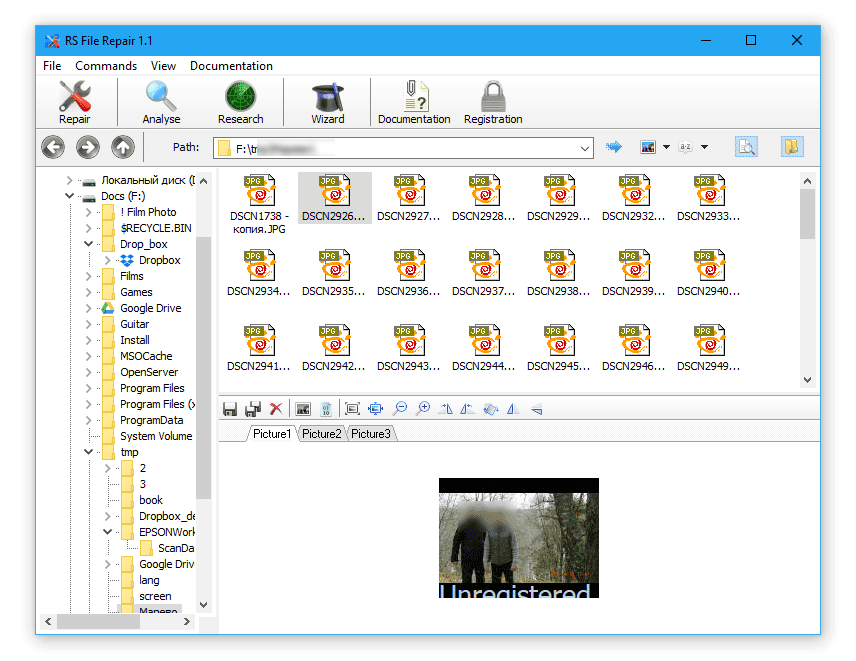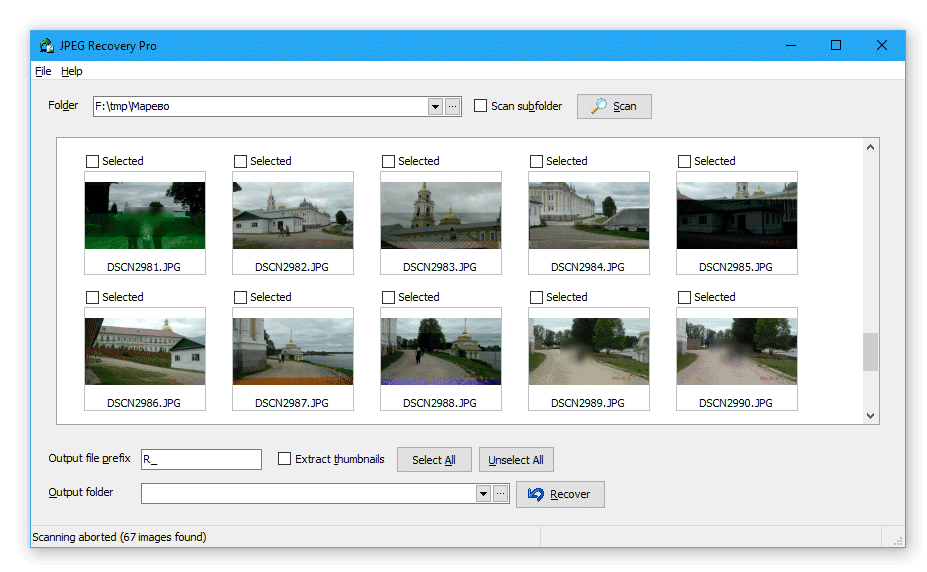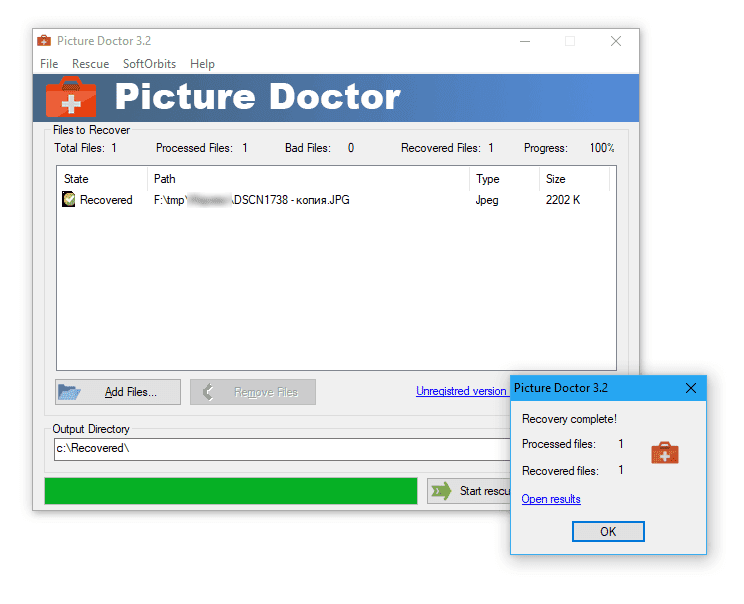- Published on
- Updated on
Top Software for JPEG Recovery: Repair and Recover Damaged JPG Files
- Authors
After recovery, many damaged files may remain, often in JPG format. Additionally, shooting with a digital camera, especially using an old SD card, can result in a lot of corrupted files that aren't suitable for storage.
Let's explore the available tools for recovering JPG (and other image formats) and see how effective they can be.
Table of Contents
PixRecovery
PixRecovery is a tool designed to recover damaged photos taken with digital cameras from brands like Kodak, Nikon, Sony, and Fuji.

Program Features:
- Recovers information in JPG images, preserving the original color depth and dimensions.
- Allows you to choose the format for saving recovered images, including JPG, BMP, PNG, TIFF, and more.
- PixRecovery supports most image formats but cannot repair progressive JPEGs.
How to Use PixRecovery to Fix JPG Files:
- Select the files to recover using the "Start Recovery Wizard" tab.
- Click "Next" and specify a folder for saving the recovered files (Set Save Folder).
- Click "Start" and wait for the process to complete.
- Review the "Data Analysis Results" and check the photos/images in the specified folder.
The program's demo version applies watermarks to saved files, which can be removed by purchasing the full version. PixRecovery's standard license costs $49.
RS File Repair
RS File Repair is a program that can fix corrupted JPEG files and recover damaged images and photos. It corrects errors caused by various issues, including viruses, software malfunctions, and physical damage to memory or flash cards.

The easiest way to start recovery with RS File Repair is through the Recovery Wizard, where you specify the files and folders to recover. RS File Repair offers two types of analysis: Analyse (a quick scan) and Research (a slower, in-depth scan). The Research option performs a more thorough analysis of the file structure.
Recovered JPG images are saved in the folder you specify. The program includes a preview feature for JPEG images, allowing you to see the recovery results within the program view, even when using the trial version.
RS File Repair is beginner-friendly, with an interface similar to Windows Explorer, making it convenient for managing and viewing source files and recovery results.
JPEGfix
JPEGfix is a small (less than 1 MB!) and free program for effectively repairing and analyzing damaged JPG files.

According to the program's description, JPEGfix can correct common errors in JPG files, such as color shifts due to errors or failures, and "grey bottom" issues caused by decoding errors.
JPEGfix performs a quick analysis to identify technical information within the damaged file that can help restore corrupted parts. However, note that this tool can't recover data that is physically missing.
Though it excels in JPEG recovery, JPEGfix is designed for experienced users. A detailed manual (translatable via Google Translate) is available for advanced guidance.
JPEGfix focuses exclusively on repairing damaged JPG files and cannot recover other image formats. However, you can save the repaired photo in BMP format in addition to JPG.
JPEG Recovery Pro
JPEG Recovery Pro is a straightforward program for fixing corrupted JPG photos. With no complex settings, the recovery process is as simple as selecting folders or files and clicking "Scan / Recover."

In addition to recovering the original file, JPEG Recovery Pro can often retrieve embedded thumbnail images, which, while lower in resolution, are frequently undamaged.
Recovered JPG files in the trial version come with a watermark and reduced quality. Purchasing the full version for $49.95 removes these limitations.
Key Features of JPEG Recovery Pro:
- Automatically detects and corrects illegal JPEG encoding and file corruption.
- Retains important metadata, including Exif data.
- Ensures that corrupted JPEG data is not written in the final file.
- Can split a file containing parts of other images into separate files.
Download JPEG Recovery Pro Trial
Picture Doctor
Picture Doctor is designed to repair corrupted images, primarily in JPEG and PSD formats, and saves them in BMP format, which can be opened in any graphic viewer.

Similar to other JPEG recovery programs, Picture Doctor restores original dimensions and color palettes. It allows for batch processing, making it easy to select and recover multiple files or folders at once.
For PSD files (Adobe Photoshop’s default format), Picture Doctor recognizes and restores layers, a unique feature that sets it apart from other recovery software.
The program’s license costs $24.99, and the demo version allows testing with watermarked results for JPEG and PSD files.
JPEG Ripper
JPEG Ripper is a tool designed for bulk extraction of images from corrupted JPEG files, allowing users to retrieve mini-images (thumbnails) with resolutions of 320x240 or 160x120, or images that would otherwise be unviewable.
Steps to Fix Corrupted Pictures with JPEG Ripper:
- Open the program, click on "Open," and select one or more JPEG files.
- For a single file, once analysis is complete, the program displays the number of undamaged images within the file, along with their sizes, and automatically selects the largest image (though you can choose another).
- Click on "Process."
- The repaired JPEG image will be saved alongside the original.
- For multiple files, select "Process," and JPEG Ripper will prompt you to choose a folder for saving the output files.
JPGscan: Utility for Assessing JPEG Repair Potential
If a photo doesn’t display in standard viewers, it doesn’t necessarily mean it’s lost. Sometimes, a simple byte modification can make it viewable again. JPGscan helps determine if a JPEG image can be recovered, and in some cases, it even displays the entire image or parts of a corrupted file.
JPGscan supports JPEG (*.JPG and *.JPEG) file formats and allows for searching these formats within other files, such as disk images. It only works with files smaller than 2GB (for larger files, you’ll need to split them, and disk images must be taken from specific sector ranges).
JPEGsnoop
JPEGsnoop includes a function to analyze the header of a JPEG file (such as quantization and Huffman tables) and can identify the camera model used to capture the image.
While JPEGsnoop doesn’t offer features for recovering or analyzing corrupted images, it is useful for viewing damaged files. Note that it won’t display image fragments if their headers are incorrect.
PhotoRescue Advanced
PhotoRescue is recommended for recovering corrupted photos, specifically from saved flash drive images.
Features, Pros, and Cons of PhotoRescue:
- Efficiently searches for images on flash drive images (works well with Handy Recovery and HexWorkshop images). Displays reduced copies (but not built-in thumbnails) found in JPEG and CRW formats.
- Accurately displays both live and deleted files, including corrupted ones, in a correct directory structure.
- Saves recovered images to disk alongside CRW files in the correct format.
- Shows hex notation and file location within the flash drive image.
- Doesn’t allow direct repair of corrupted files after recovery; you can only trim file parts to prevent unnecessary disk space usage.
- Doesn’t display THM files in directory view, only in single file mode.
FastStone Image Viewer
FastStone Image Viewer is an easy-to-use tool for previewing recovered RAW images. It displays a JPEG preview, either full-size or as a thumbnail, allowing for a quick check of the file’s integrity. The conversion feature also extracts RAW data, which is stored in separate blocks within the file—one of which may be less corrupted or entirely undamaged.
DMDE
DMDE is a data recovery tool capable of recovering various file types, including images. It supports RAW-search for locating files based on their signatures.
ZAR (Digital Image Recovery)
ZAR, or Digital Image Recovery, is a program designed to locate and retrieve images from damaged storage devices, such as formatted drives.
Download Digital Image Recovery
Questions - Answers
Q: I've accidentally deleted my entire family archive and recovered it using PhotoRec. I managed to restore about 70% of the files, but the rest are unreadable. I can see previews of the photos in thumbnail view, but no viewer will open them. How can I recover these corrupted photos?
A: Some useful data might still exist within the JPG files. Try opening them in various viewers like IrfanView or XNView. If the Thumbs.db file is intact, you can use it to recover thumbnails. If you’re familiar with JPG file structure, you can open the files in a hex editor like WinHex or Disk Tools and attempt to edit their headers.
Q: I can no longer view photos taken over the past year. Browsers like IE and Opera can’t open them, and photo viewers and Photoshop can’t identify the file type. I tried opening them on different computers with different Windows versions, but no luck.
A: If there’s no header, it’s likely not a valid JPEG file. To avoid future issues, consider storing your photos in cloud services like Dropbox or Google Drive.
Q: Help! I transferred photos from my camera to my computer, then to a USB flash drive. Now most of my photos are corrupted (almost 500 MB), except for a few. When I open any of them, I only see the top part of the image, and the rest is grey. Could this be due to using USB 1.1 instead of 2.0? Is there a way to restore these photos?
A: There’s a chance of recovering JPG files in this case. The grey area often indicates an issue with an FF byte in the image body, followed by a byte other than 00. Since this sequence is forbidden by the JPEG format, decoders will flag an error. Try searching for these bytes (look for FF FF) and change them to FF 00 using a hex editor like HexWorkshop.
Q: I transferred a large album of digital photos to a USB flash drive, but the drive had bad blocks and now I have about 2 GB of corrupted photos. Despite trying various recovery programs, I managed to recover less than half. The rest remain broken, even after following repair instructions. Any advice?
A: Unfortunately, there’s no universal solution. If you’re limited to a hex editor, you might be able to edit the headers. However, JPEG files have minimal redundancy, making it difficult to pinpoint damage. If color distortion or shifts are visible, estimate where it starts, as each “square” of damage may represent around 20 bytes. This approach can be time-consuming.
Q: After using DiskDigger to recover my photos, the file sizes are intact, but only low-resolution previews (160x120) are visible. EXIF data is still present, including my camera model. Is there any chance of recovering these images?
A: There is a slight chance, but full recovery is unlikely. In cases where files have been through multiple recovery programs, like EasyRecovery, the files often contain fragments of unrelated data. However, sometimes the main part of the image remains intact.
Q: Why can I only see a small preview of the picture and not the full damaged photo?
A: The small preview is a thumbnail stored at the beginning of the file. If this part of the file is undamaged, the thumbnail will display normally, even if the rest of the file is corrupted.
Result: 0, total votes: 0

I'm Vladimir, your guide in the expansive world of technology journalism, with a special focus on GPS technologies and mapping. My journey in this field extends over twenty fruitful years, fueled by a profound passion for technology and an insatiable curiosity to explore its frontiers.